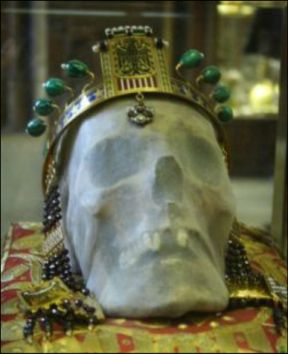The Skull of Good King Vaclav

Good King Vaclav was the son of Stanislaus I, the penultimate king of Hemiboa. His grandfather, Boris I of Hemiboa, was converted to the Via Lucis by Saints Cyril and Methodius. Vaclav’s mother, Dragoríma, was the daughter of a pagan tribal chief, but she was baptized into her husband’s faith at the time of her marriage. Vaclav’s paternal grandmother, Dulmila of Hemiboa, oversaw his education, Vaclav excelled as a scholar and at an early age was sent to the college at Weisblud.
When Vaclav was thirteen, Stanislaus, who had become king just a few years before, died and Dulima became regent, a move which enraged Dragoríma so much that she arranged to have Dulima murdered by assassins. Reportedly, these killers strangled Dulima with her veil. After this, Dragoríma assumed the role of regent, and immediately initiated measures against the Via Lucis. When Vaclav came of age, he wrested control of the government from his mother and countermanded the persecution of the Via Lucis. Vaclav had Dragoríma exiled, and then went on to put down a major rebellion led by Duke Mouřik, one of his wicked mother’s paramours.
Eleven years into Vaclav’s reign, a group of nobles allied with Vaclav’s younger brother, Boreslav, plotted to kill Vaclav. Boreslav invited Vaclav to the celebrate a holy day with a feast. Three of Boreslav’s lackeys attacked Vaclav during dinner, stabbing the young king several times before Boreslav ran Vaclav through with a lance. The kingdom fell into civil war shortly after Vaclav’s murder. Even now, Hemiboa remains fractured and unstable.
Vaclav was widely hailed as a martyr saint almost immediately after his death. Although Boreslav tried to dispose of the body in the wilderness, followers loyal to Vaclav retrieved the corpse and hurried into a Weisblud, which has since become the center of Vaclav’s cult. Vaclav’s skull ranks chief among the saint’s relics. For decades, it was kept under guard in Weisblud’s cathedral, but just a few years ago thieves stole it. Vaclav’s skull remains missing to this day.
All manner of stories surround the lost relic. Some claim descendants of Boreslav paid to have the skull taken, and that these evil scions use the relic in profane rituals. Other tales say the thieves were killed crossing into the Recondite Frontier and that the skull was lost in a rain-swollen river. In and around Weisblud, the most common legend holds that the skull vanished when the thieves left the city with it. Angels took the skull up into the mountains above Weisblud, hiding it in a cave. When a time of great evil befalls the city, Vaclav himself will descend from Heaven, take up his skull, and lead an army of the righteous dead to reunify Hemiboa and place a rightful heir on the throne.
In the hands of a faithful cleric of the Via Lucis, the Skull of Good King Vaclav acts as a bronze horn of Valhalla. Evil characters who so much as touch the skull lose 1 full experience level, dropping to the lowest possible number of experience points to hold the level. If the evil character is a cleric, he must also atone in an appropriate manner; until then, he cannot cast cleric spells higher than 1st level. The Skull is rumored to have other powers as well, which may be chosen from Artifacts and Relics Powers/Effects Tables (see pages 162-164, Dungeon Masters Guide). The Skull of Good King Vaclav reportedly has these powers/effects: Minor Benign Powers x2, Major Benign Powers x1, Minor Malevolent Effects x2, Major Malevolent Effects x1, and Prime Powers x1.

Leave a Reply